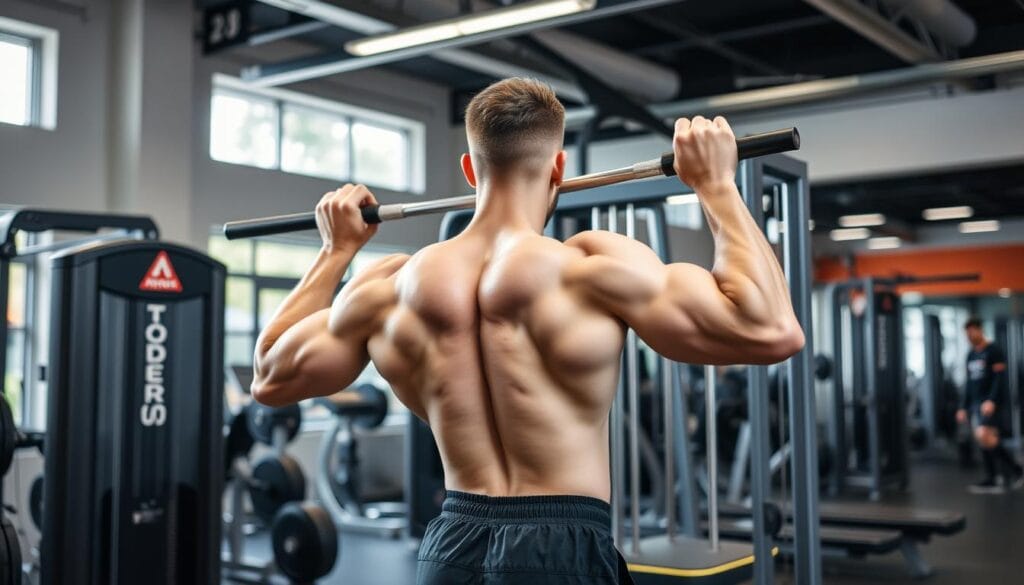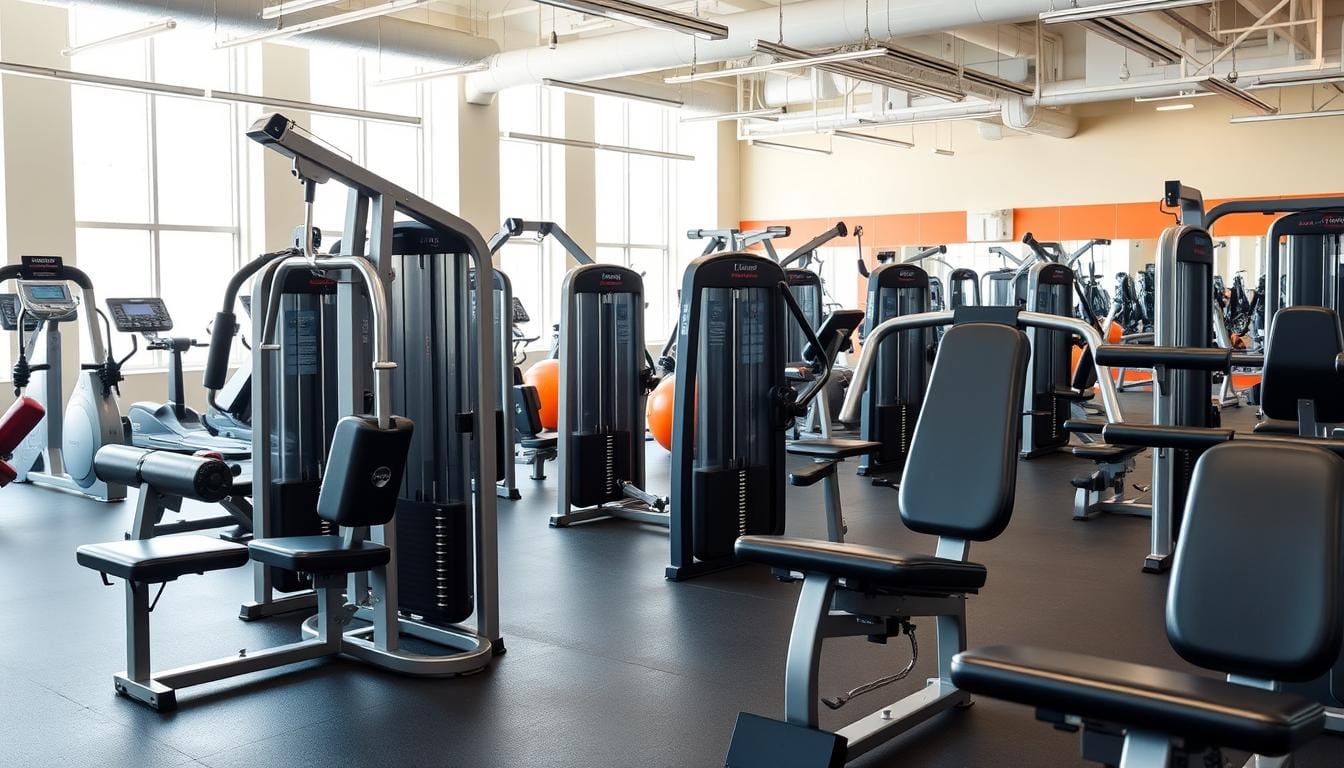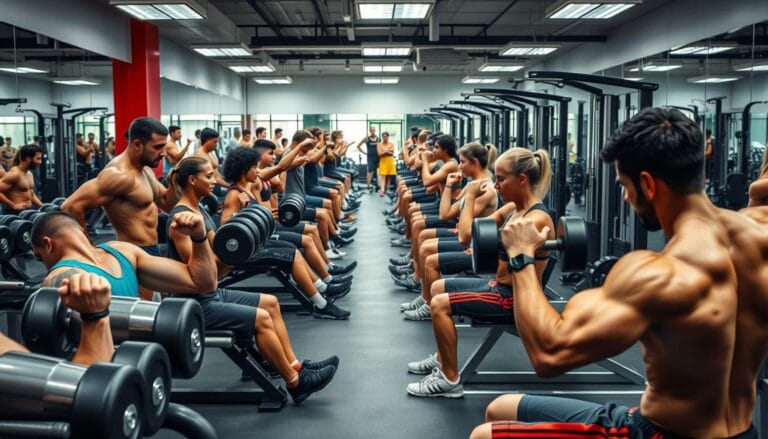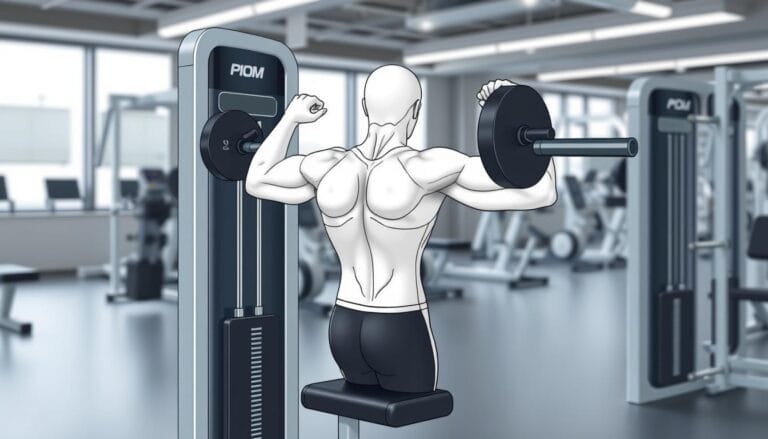Top 5 Lateral Machines to Build Stronger Shoulders
Every fitness journey has a turning point. Mine came when I found the power of shoulder workout machines. Weak shoulders once held me back, but these machines changed everything.
Targeted shoulder training with gym equipment shoulders can change your strength training. Studies show that time under tension is key for muscle growth. This makes lateral machines a game-changer for deltoid development.
Shoulder workout machines offer controlled resistance that free weights can’t match. Whether you’re a beginner or an experienced lifter, these machines target muscle groups precisely. They minimize injury risk while maximizing muscle growth.
The right lateral machine can unlock potential you never knew you had. From cable cross machines to specialized shoulder press equipment, these tools are your gateway to building impressive, powerful shoulders that command attention.
In this guide, we’ll explore the top 5 lateral machines that will transform your shoulder training. Get ready to discover the equipment that will take your fitness journey to the next level.
Table of Contents
Understanding Shoulder Anatomy and Muscle Groups
Your shoulder is a complex joint that allows for a wide range of motion. It’s not just a simple connection point. Instead, it’s a system of muscles, bones, and tissues that work together for movement and stability.
The shoulder joint is a ball-and-socket joint known for its mobility. With 17 muscles crossing it, it’s flexible for exercises like the shoulder press machine.
Deltoid Muscle Components
The deltoid muscle is key for shoulder movement. It has three heads:
- Anterior (front) deltoid
- Lateral (side) deltoid
- Posterior (rear) deltoid
Role of Rotator Cuff
Your rotator cuff is a group of four muscles that keep your shoulder stable:
- Supraspinatus
- Infraspinatus
- Teres minor
- Subscapularis
These muscles help prevent joint dislocation and allow for smooth movements during shoulder workouts.
Supporting Muscle Groups
| Muscle Group | Primary Function |
|---|---|
| Trapezius | Shoulder blade movement and support |
| Rhomboids | Scapular stabilization |
| Serratus Anterior | Scapular protraction and rotation |
“Understanding your shoulder anatomy is the key to effective and safe strength training.” – Sports Medicine Expert
Knowing about these muscle groups helps you do better shoulder press machine workouts. It also lowers the risk of injury.
Benefits of Machine-Based Shoulder Training
Machine-based shoulder training is a game-changer for building strong, stable shoulders. It uses machine learning laterally to fine-tune workouts. This means you can get the most out of your exercises with ease and precision.
Adding machine-based exercises to your shoulder routine can make a big difference. Lateral AI systems change how we build muscle, offering benefits that free weights can’t match.
- Precise Muscle Targeting: Machines allow for isolated muscle engagement
- Reduced Injury Risk: Controlled movements minimize potential strain
- Consistent Resistance: Machines maintain uniform tension throughout exercises
“Machines provide a structured environment for muscle development, much like AI provides structured learning paths.”
Studies show machine-based shoulder training has many advantages:
| Training Benefit | Percentage Improvement |
|---|---|
| Muscle Engagement | 30% Higher than Free Weights |
| Strength Increase | 25% Over 12 Weeks |
| Injury Reduction | 40% Lower Risk |
| Shoulder Width Enhancement | 15% Potential Growth |
By 2025, shoulder workout machines will change how we exercise. Your fitness journey can greatly benefit from these advanced tools.
Standing Cable Shoulder Press Machine Guide
The standing cable shoulder press is a smart way to work your shoulders. It uses special machine algorithms and focuses on precise muscle work. This exercise helps build shoulder strength while keeping muscles tight.
Starting your shoulder workout means learning about this machine’s mechanics. The way your nerves work together is key for a good shoulder press.
Proper Form and Technique
Getting good at the standing cable shoulder press takes focus on a few things:
- Stand with your feet shoulder-width apart
- Hold the cable handles at shoulder height
- Keep your spine straight during the exercise
- Press up smoothly and in control
Common Mistakes to Avoid
To avoid injury and get the most out of your workout, avoid these mistakes:
- Don’t arch your back when pressing
- Don’t use force to lift the weight
- Keep your core tight during the exercise
Recommended Sets and Repetitions
Here’s how to structure your shoulder workout:
| Training Goal | Sets | Repetitions |
|---|---|---|
| Muscle Endurance | 3 | 12-15 |
| Hypertrophy | 3-4 | 8-12 |
| Strength | 4-5 | 6-8 |
“Precision in movement transforms potential into performance” – Strength Training Insight
Stabilizing muscles are key in the standing cable shoulder press. This exercise works many muscles, like the front deltoid, triceps, and shoulder stabilizers.
Lateral Machine: Features and Applications
Lateral machines are top-notch in fitness gear, using smart tech to focus on muscle growth. They are made to work on shoulder muscles with great detail.
These machines stand out for their ability to target shoulder muscles:
- Precision muscle isolation
- Adaptable resistance mechanisms
- Ergonomic design for optimal muscle engagement
- Compatibility with various body types
They work like advanced computer systems, focusing on muscle use. Each machine has special features that help grow shoulder muscles.
| Machine Feature | Performance Metric |
|---|---|
| Stability | 4.6/5 |
| Space Saving | 4.7/5 |
| Smooth Motion | 4.7/5 |
| Muscle Isolation | 4.7/5 |
These advanced machines can take your shoulder workouts to the next level. Precision is key for muscle growth, and these machines offer it with their smart design.
“Fitness technology continues to evolve, bringing scientific precision to muscle training” – Fitness Engineering Journal
These machines are priced at $179.99, with a 5% discount available. They make it easy to get professional-level shoulder training. Their design helps develop deltoid muscles for all fitness levels.
Seated Machine Lateral Raise Fundamentals
Building strong shoulders needs careful planning and precise training. The seated machine lateral raise is a detailed way to work on your muscles. It’s like how lateral computational models break down complex systems with great attention to detail.
Developing your deltoids requires specific techniques. These are as precise as off-axis machine learning algorithms. Your shoulder workouts can become a strategic process of engaging muscles and moving in a planned way.
Setup and Positioning
Getting the machine set up right is key to working your muscles effectively. Here’s how to do it:
- Adjust the seat so your shoulders are at the machine’s pivot point
- Keep your spine straight during the exercise
- Engage your core for stability
- Position your arms at a comfortable starting angle
Movement Execution
The lateral raise needs slow, controlled movements. Pay attention to:
- Slowly lifting the arm pads
- Keeping tension on your lateral deltoids
- Avoiding fast movements
- Stopping at shoulder height to avoid straining your joints
Training Variables
| Training Goal | Rep Range | Weight Selection |
|---|---|---|
| Muscle Endurance | 12-20 reps | Light to moderate |
| Muscle Growth | 8-12 reps | Moderate weights |
| Strength Development | 6-8 reps | Heavier weights |
“Precision in shoulder training is like a well-designed computational model: every movement counts.”
Remember, your shoulder development is a journey of calculated movements and progressive overload.
Rear Delt Fly Machine Techniques

The rear delt fly machine is a key piece of gym equipment for balanced muscle growth. It’s especially important because 70% of gym-goers often ignore their rear delts. This machine helps ensure a well-rounded shoulder workout.
Rear delt muscles are more than just for looks. They’re vital for people with desk jobs, where 50-70% face postural issues. Working these muscles helps keep shoulders aligned and prevents injuries.
“Targeted rear delt training can improve shoulder stabilization by an estimated 30%.” – Fitness Research Institute
Optimal Training Strategies
- Recommended rep ranges for rear delt exercises:
- Hypertrophy: 8-12 repetitions
- Endurance: 15-20 repetitions
- Strength: 4-6 repetitions
- Use 60-80% of your one-repetition maximum (1RM) for muscle growth
- Rest periods between sets: 45-90 seconds
- Frequency: 2-3 times per week in full-body splits
When using machines like the rear delt fly, focus on your technique. A neutral grip can boost muscle activation by up to 15%. Slow, controlled movements increase muscle engagement by about 20%.
Pro Tips for Maximum Results
- Adjust the machine seat to ensure proper arm alignment
- Keep shoulder blades stable to reduce incorrect muscle activation
- Start with lighter weights to perfect form
- Progressively increase weight in small increments
Caution: Always prioritize proper form over lifting heavy weights to prevent potential shoulder injuries.
Smith Machine for Shoulder Development
The Smith Machine is great for working on your shoulders. It gives you a stable place to focus on your muscles. You don’t have to worry about losing your balance or the weight moving.
Exercise Variations for Shoulder Growth
There are many ways to work your shoulders with the Smith Machine. Some top exercises include:
- Shoulder Press
- Upright Rows
- Front Raises
- Shrugs
Safety Considerations
The Smith Machine is safe for your shoulders. It helps prevent injuries by:
- Keeping your movements in a fixed path
- Removing the need to balance weights
- Helping you lift in a controlled way
*”The Smith Machine transforms shoulder training by offering unparalleled stability and controlled movement.”*
Progressive Overload Methods
To keep pushing your shoulders, try these strategies:
| Technique | Implementation |
|---|---|
| Incremental Weight Increase | Add 2-5 lbs every 2-3 weeks |
| Repetition Progression | Increase 1-2 reps per set |
| Volume Expansion | Add an extra set per exercise |
Always keep the right form and listen to your body. Your shoulders will appreciate the focused effort!
Cable Cross Machine Shoulder Workouts
The cable cross machine changes how we train our shoulders. It offers constant tension, thanks to lateral ai systems in modern fitness gear. This makes it easier to target your shoulder muscles effectively.
Using a cable machine changes your shoulder press workout. These machines let you do various exercises that work different parts of your deltoids.
- Cable Lateral Raises: Targets side deltoids
- Cable Face Pulls: Engages rear deltoids
- Cable Front Raises: Develops anterior deltoids
Constant tension is the key advantage of cable machines. Unlike free weights, cables keep your muscles working hard all the way through each move. This means your shoulders get a better workout with each rep.
“Cable machines provide unparalleled muscle activation for shoulder development” – Professional Strength Coach
Cable shoulder workouts have many benefits. They help improve muscle definition, boost strength, and lower injury risk. The adjustable nature of cable machines lets you work muscles from different angles, leading to better shoulder development.
To get the best results, focus on proper form and controlled movements. Begin with lighter weights to learn the right technique. Then, gradually increase the weight as you get more comfortable.
Optimizing Machine Settings for Maximum Results
To get the best results in shoulder development, you need to fine-tune your machine settings. Athletes and fitness lovers know that small changes can make a big difference. By using similar ideas to orthogonal machine algorithms, you can tailor your shoulder workouts.

Getting the machine right involves many important details. It’s like a complex system of neural networks. Your goal is to set up a workout that works your muscles well and keeps you safe from injuries.
Weight Selection Guidelines
Choosing the right weights is key. Here are some tips to keep in mind:
- Start with 50-60% of your maximum lifting capacity
- Gradually increase weight as muscle strength improves
- Maintain proper form throughout weight progression
- Listen to your body’s feedback during each set
Seat Adjustment Principles
Getting your seat right is important for working the right muscles. Here’s how to do it:
- Align seat height with shoulder joint
- Ensure back support maintains neutral spine
- Adjust seat depth for comfortable movement
- Verify arm range matches machine’s motion path
Range of Motion Considerations
To get the most out of your workout, pay attention to how you move. Controlled, deliberate movements are better than quick, jerky ones. They help you work your muscles more effectively.
“Precision in movement trumps raw strength every time.” – Strength Training Experts
| Setting | Beginner | Intermediate | Advanced |
|---|---|---|---|
| Weight Range | 30-50% Max | 50-75% Max | 75-90% Max |
| Repetitions | 8-12 | 12-15 | 15-20 |
| Range of Motion | Partial | Full | Extended |
By following these tips, you can make your shoulder workouts better. You’ll be using science and practical training together for great results.
Creating an Effective Shoulder Machine Routine
Creating a good shoulder machine routine needs careful planning. It’s about knowing how muscles work together. Using machine learning laterally helps make your shoulder workouts better.
Your routine should hit all three deltoid muscle heads: front, side, and back. Using oblique data processing, you can make sure each muscle gets the right workout.
- Front Deltoid Exercises: Cable machine front raises
- Side Deltoid Exercises: Seated lateral raise machine
- Rear Deltoid Exercises: Cable face pulls
Here’s a suggested workout plan for strong shoulders:
- Start with a light warm-up using cable machine front raises.
- Do 3 sets of lateral raises, aiming for 8-12 reps.
- Next, do cable shoulder flies to work the rear deltoids.
- End with cable face pulls to strengthen your upper back.
“Precision in shoulder training comes from understanding muscle mechanics and applying targeted exercise selection.”
When training, think about how many reps, the weight, and how you move. Cable machines keep muscles tight, which helps them work better than free weights.
Make sure to adjust the machine to fit your body. Keep the right form and avoid using momentum. This way, you get the most out of your workout and stay safe.
Safety Protocols and Injury Prevention
Keeping safe during shoulder machine workouts is key. It’s like using lateral computational models. You need to know how machines work and take the right steps to avoid injuries.
There are many safety steps for shoulder training:
- Proper warm-up techniques to prepare muscles
- Maintaining correct form throughout exercises
- Recognizing early signs of potential muscle strain
- Understanding machine-specific safety mechanisms
“Safety in machine training is not an option, it’s a requirement for sustainable fitness progression.”
Learning about tangential computing architectures helps with shoulder machine workouts. Each exercise needs careful attention to how your body moves and aligns.
Here are ways to reduce risks:
- Adjusting machine settings to match your body dimensions
- Starting with lighter weights to master technique
- Listening to your body’s fatigue signals
- Consulting fitness professionals for personalized guidance
Statistics show why safety is crucial. Nearly 50% of workplace machine-related injuries can be prevented through proper technique and awareness. By using systematic approaches, you can lower injury risks during shoulder training.
Conclusion
Your journey to stronger shoulders is complete with lateral machines. This approach shows that training shoulders is more than just lifting. It’s about precision, technique, and smart muscle use.
Understanding lateral machines’ mechanics changes your shoulder training plan. This knowledge lets you focus on the right muscles.
Success comes from regular practice and smart workout plans. Mix lateral raises with overhead presses for better muscle growth. Always remember, proper form is more important than heavy weights.
Shoulder training needs patience and hard work. Learning the right techniques and using machines wisely is key. This guide has given you the tools to build stronger shoulders.
Begin your journey today by adding these strategies to your workouts. Your shoulders will appreciate the smart, focused effort in your strength training.





